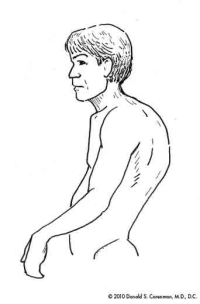An Overview of Hyperkyphosis & Scheuermann’s Disease
A normal curvature of the spine exists with every human. The thoracic spine has a natural curve viewed on the side called a kyphosis. The vertebral bodies are wedged shaped and are the reason the curve is shaped like a kyphosis. The normal curve of the spine measures from 20-40 degrees. When this normal curve is disrupted, a deformity of the spine coupled with thoracic back pain can result.
This curve is essential for postural balance. There are two mirror image curves above and below (the cervical and lumbar curves). When added together with the sacral curve (the base bone of the spine is normally angulated 40 degrees to the front) the spine is in perfect balance. This means the head is positioned directly over the pelvis and no energy in the form of muscle contraction is necessary to stay upright.
This balance can be distorted by increasing the thoracic kyphosis as is seen in degenerative hyperkyphosis syndrome, Scheuermann’s Disease and postural round-back deformity. An unnatural curvature of the spine is detected in all of these disorders of the spine because the thoracic curve is increased and the balance of the spine is put off.
Compensation needs to come from the lumbar spine and cervical spine in the form of increased lordotic curves (the opposite curves to the thoracic curve to balance the spine). Without increased curves in these areas, the patient will either be thrown forward (if the lumbar curve does not increase) or have the head looking down instead of forward (if the cervical curve does not increase).
A helpful video on this website: “Hump-Back, Increased Thoracic Kyphosis, Scheuermanns Disease and Degenerative Kyphosis” helps to demonstrate the importance of normal balance and how the normal curves of the spine (cervical and lumbar lordosis and thoracic kyphosis) balance each other out. These disorders of the spine are examined in this video.
Symptoms Associated with Hyperkyphosis & Scheuermann’s Disease
The increased cervical and lumbar curves create amplified wear on the facets as the neck and lower back have to hyperextend (bend further backwards) to accommodate the thoracic imbalance. The increased curves have to be “held in place” by increased muscle contraction which causes muscle fatigue and pain from prolonged muscle contraction. Neck and or lower back pain will result.
The thoracic spine can generate local thoracic back pain from overload of the vertebral bodies and discs. In addition, with aging, arthritis of the spine, and osteoporosis, the increased loading of the vertebra can cause fractures of the spine by simply stepping off a curb too hastily.
Fatigue and muscle spasms can be a common complaint with hyperkyphosis / Scheuermann’s Disease as muscle overload uses too much energy. Prolonged walking or activities that require being upright can cause exhaustion.
Are you suffering from symptoms associated with Hyperkyphosis & Scheuermann’s Disease?
Would you like to consult with Dr. Corenman about your condition?
You can set up a long distance consultation to discuss your
current X-rays and/or MRIs for a clinical case review.
(Please keep reading below for more information on this condition.)
Treatment for Hyperkyphosis & Scheuermann’s Disease
Non-Surgical
Like with most other disorders of the spine, physical therapy using prescribed exercises for the spine, chiropractic treatment of the spine, medications and injections can be very helpful to manage the thoracic back pain associated with hyperkyphosis / Scheuermann’s Disease.
Surgical
Surgery for the treatment of kyphosis or for a deformity of the spine where the natural curve exceeds 65 degrees can be considered. Surgery is no small undertaking as the curve has to be straightened and there are significant risks to surgery. If the curve is under 65 degrees, a more conservative form of treatment of kyphosis should be discussed with your doctor.
For more information on curvature of the spine, or a specific deformity of the spine such as thoracic kyphosis, degenerative hyperkyphosis syndrome, Scheuermann’s Disease and postural round-back deformity, please contact the office of Dr. Donald Corenman, back surgeon and spine specialist offering diagnostic and surgical second opinions to patients in the USA and around the world.

(Click to Enlarge Image) This is a picture of the normal alignment of the spine when viewed from the side (sagittal alignment). The curves of the neck and lower back are in the same direction (lordosis) and the mid-back curve (kyphosis) is reversed. All curves add up to make the spine align with the head directly over the pelvis.

(Click to Enlarge Image) This is a side view diagram of a patient with Scheuermann’s hyperkyphosis disease. The mid back (thoracic spine) has a much bigger curve than normal. Note the thick black arrow pointing to the increased curve. This causes the patient to be tilted forward (see the thin gravity line in front of the pelvis which should be pointed into the pelvis). To compensate, the patient must increase the size of the lumbar curve which can prematurely wear it out.


